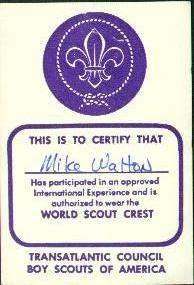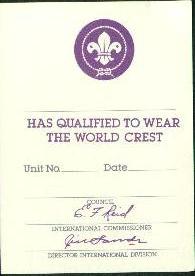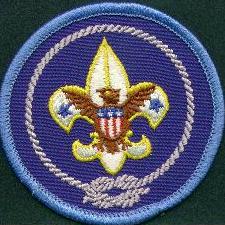 |
> updated 11/05/09

This special emblem may be worn by ALL members registered during 2009-2011 and is worn ON TOP OF
(with the World Crest emblem in the center) as shown below:

|
|
|
The World Crest emblem...
All
Uniform
Left Side
The World Crest
The World Crest emblem...
Description:
The patch has always had the same design. The patch is one-inch in diameter, in the same two colors. The design is the
international fleur-de-lis (flower of the lily), with two stars symbolizing "truth" and "knowledge" and alluding to the outdoor
nature of Scouting, surrounded by a rope symbolic of unity and one-ness ties at the bottom by a square knot, a symbol of
service. Those white items are on a deep purple (not maroon, but royal purple) background.
The 1995 Insignia Guide states that the World Crest should be centered horizontally over the left shoulder and vertically
between the left shoulder seam and the top of the pocket. More recent Insignia Guides state that it is just worn by all members
"above the left pocket". For best uniforming, the emblem should be worn two inches below the top edge of the shoulder seam
on the upper left side of the uniform shirt. It is worn in the same location regardless of uniform color.

Background:
The World Crest is a smaller symbol associated with the World Scout Flag which flies at the World Organization of Scouting
Movements (WOSM) in Switzerland. It is the sole insignia common to ALL member nations of the WOSM, and in most if not
all nations, where they base "their" national symbol of Scouting from. Only recently, has the Boy Scouts of America decided
that all of its members will wear the World Crest as a symbol of unity and world brotherhood.
The World Organization decided after the second World War that all member nations would issue and wear a patch with the
World Crest on it as a sign of world brotherhood and unity among all Scouting organizations in teh then "free world". The BSA
along with a small group of other countries agreed but declined to carry out the mandate, stating that their program "will do
so when the time is right for it to happen", stated then-Chief Scout Arthur Schuck.
The first uses of the World Crest was during the World Jamboree in 1955, although the badge was available to Scouts and
Scouters several years before. In 1956, however, the BSA decided that Scouts and Scouters that participate in an approved
"international activity or event" would wear the Crest to and from that event as members of other nations would be doing.
The following year, 1957, the BSA made the World Crest available to local Councils (it was previously only avaialbe from the
BSA's International Service), and established the requirements which lasted until 1991: "take part in an organized international
activity or event with Scouts from another member nation of the World Association". It also established the World Crest as one
of the few PERMANENT patches or insignia on the Boy Scout or Scouter's uniform.
No matter how many "international activities" you took part in, you could only wear ONE per life of the Scout. Nor could you
purchase a World Crest without a card (similar to the Eagle Scout card) which states that you are indeed the holder of the
World Crest.

The crest became known as the "Overseas" patch of Scouting informally by Scouts and Scouters, because while a few were
earned by Scouts and Scouters taking part in events in Canada or Mexico, many more...the majority...were earned by Scouts
and Scouters serving as members of the Transatlantic (Europe, Near East, and North Africa), Far East (Far East, Japan, and
the Phillipines), Canal Zone (Panama) and Direct Service (all other areas around the world) Councils. Scouts and Scouters in
those Councils routinely had interactions with host-nation Scouting groups and many of those Scouts and Scouters developed
lifelong associations with individuals and groups over the years, camping and doing social events with them and their members. As those folks came back to the States, proudly displaying their World Crest, they were singled out for many special tasks and events in their Councils because "they have done something with foriegn Scouts".

So why does EVERYONE get to wear it now?
My best guess is that there were many jealous Scouts and Scouters that could not go overseas, could not atttend a Jamboree
or some other event, and could not, therefore, earn the World Crest. The BSA did something about this, in 1990, and changed
the rules allowing for Scouts and Scouters in the USA to earn a World Crest by simply "taking part in an international exhibit or
display or an international event.", whether or not Scouts from another country were present or not. Robert Zadima, the
Council Executive of the Transatlantic Council and his Far East counterpart, along with some members of other US local councils,
strongly made their objections known to the BSA's National Director of Operations and to the International Division, but those
appeals fell on deaf ears, and the policy was changed.
In 1991, the BSA once again changed the policy over the objections of many local councils, whose volunteers and professionals
had grown to respect the World Crest and what it stood for. The present policy is that the patch WILL BE WORN BY ALL
YOUTH MEMBERS AND BY ALL ADULTS, VOLUNTEER OR PROFESSIONAL, AS A SIGN OF WORLD BROTHERHOOD AND UNITY
WITH OTHER MEMBERS OF THE INTERNATIONAL SCOUTING COMMUNITY.
Is there anything that has taken the place of the World Crest?
In order to earn the World Crest Badge before 1991, you must have participated in an international Scouting event or activity
lasting five days or more. Today, each local Council has the authority to determine requirements for the International Activities
badge, a 3-inch patch which is worn as a TEMPORARY EMBLEM on the right pocket of the Scout or Scouter. It is
NOT worn in the PLACE OF or alongside the World Crest emblem.

Additionally, the BSA has developed the World Conservation Awards for Boy Scouts and Cub
Scouts and this emblem is likewise a TEMPORARY EMBLEM to be worn on the right pocket of the Scout. Scouters
cannot earn the World Conservation Award. The World Conservation Award is NOT a PERMANENT award, and
therefore only the World Crest Badge is worn on the left side of the shirt above the pocket (or above square knot insignia
and/or year pins).
Here are one local Councils' requirements for the International Activities Badge;
and here are my comments and opinions on the current usage
of the World Crest Badge.
Settummanque!
Back to the Top of this Page
Credits: Scans courtesy of Mike Walton
This webpage is designed for printing, three-hole punching, and insertion into
Your Binder!
 Back to The Tree Back to The Tree
 Insignia mainpage Insignia mainpage
© 2009 Settummanque!
Designed by
Mike Walton

Created with the CoffeeCup HTML Editor
*Boy Scouts of America®, BSA®, the Universal Emblem, Arrow of Light®, Cub Scouts®, Eagle Scout®, Scouting®, Order of the Arrow®
and all other related marks and insignia, are either registered trademarks or trademarks of Boy Scouts of America in the United States and/or
other countries. All other trademarks are the property of their respective owners.*
|